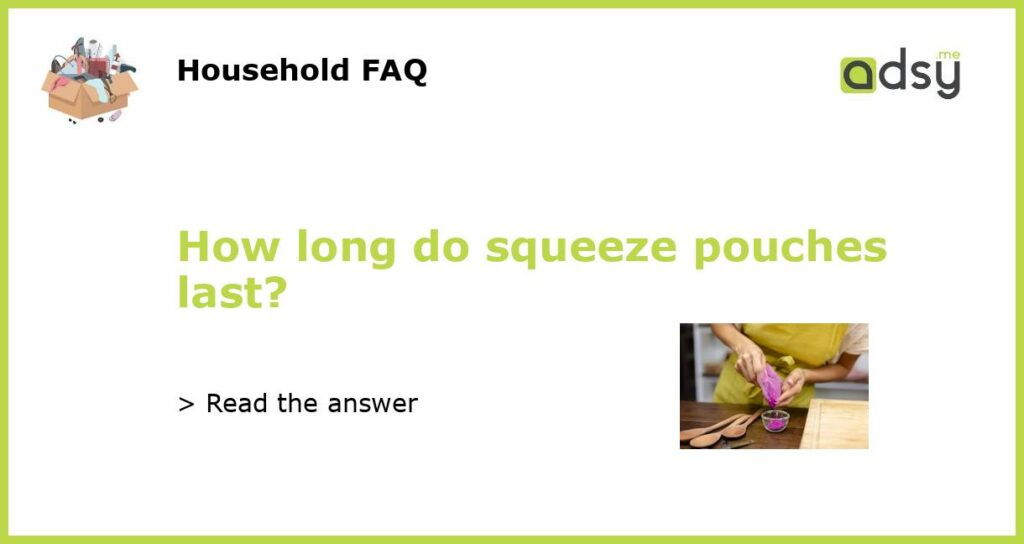How Long Do Squeeze Pouches Last?
Squeeze pouches have become a popular option among parents for feeding their babies and toddlers. These convenient and portable pouches offer a mess-free way to pack and feed pureed foods. While they are indeed convenient, many parents wonder how long squeeze pouches actually last.
The Shelf Life of Squeeze Pouches
Squeeze pouches typically have a shelf life of around 1-2 years, depending on the brand and the specific product. This shelf life refers to the length of time that the food should remain fresh and safe to consume when stored properly. It is important to check the expiration date on the packaging before feeding the contents to your child.
In general, squeeze pouches are designed to have a relatively long shelf life because they are made with a process called high-pressure processing (HPP). HPP involves applying high levels of pressure to the product, effectively killing harmful bacteria and extending the shelf life without the use of preservatives. The HPP process helps to ensure the safety and quality of the food within the pouch.
Proper Storage of Squeeze Pouches
To maximize the shelf life of squeeze pouches, it is crucial to store them properly. Here are some key tips for storing these pouches:
1. Check the packaging: Before purchasing a squeeze pouch, always check the packaging for any signs of damage, leaks, or bulging. If the packaging appears compromised, avoid purchasing or using the pouch.
2. Store in a cool, dry place: Squeeze pouches should be stored in a cool, dry place away from direct sunlight. Heat and humidity can accelerate the deterioration of the product, potentially leading to spoilage.
3. Avoid extreme temperatures: Do not expose squeeze pouches to extreme temperatures, such as freezing or excessive heat. Extreme temperatures can compromise the integrity of the packaging and the quality of the food inside.
4. Refrigerate after opening: Once a squeeze pouch has been opened, it is crucial to refrigerate any remaining contents. The cold temperature of the refrigerator helps slow down the growth of bacteria and preserves the freshness of the food. Use opened pouches within 24 hours or follow the specific recommendations provided by the manufacturer.
Signs of Spoilage
While squeeze pouches generally have a long shelf life, it is important to be vigilant and check for signs of spoilage before feeding the contents to your child. Here are some signs that a squeeze pouch may be spoiled:
1. Unusual odor: If the contents of the squeeze pouch have an off-putting or unpleasant odor, it is best to err on the side of caution and discard the pouch.
2. Strange texture or appearance: If the food inside the pouch appears discolored, has visible mold growth, or has an abnormal texture, it is likely spoiled and should not be consumed.
3. Strange taste: If you or your child notice any unusual or unpleasant taste when consuming the contents of a squeeze pouch, it is wise to stop eating and discard the pouch.
When in doubt, it is always better to be safe than sorry. If you have any concerns about the freshness or safety of a squeeze pouch, it is best to discard it and choose a new pouch for your child.
The Importance of Check Squeeze Pouch Expiration Dates
When it comes to squeeze pouches, checking the expiration date is crucial. Expiration dates are placed on packaging for a reason – they indicate the date until which the product is guaranteed to be fresh and safe to consume if stored properly. Consuming expired food can pose health risks, especially for infants and young children with developing immune systems.
Always make an effort to check the expiration date on squeeze pouches before feeding them to your child. When purchasing pouches, aim to select the ones with the furthest expiration dates to ensure a longer shelf life.
Squeeze pouches can be a convenient and nutritious option for feeding babies and toddlers. These pouches typically have a shelf life of 1-2 years, depending on the brand and product. To ensure the freshness and safety of the pouches, store them properly in a cool, dry place and refrigerate any opened pouches. Check for signs of spoilage and always check the expiration date before using a squeeze pouch.






